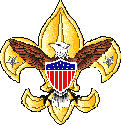| MERIT BADGES |
|
|
|
|
| Note: Eagle Required are in Italics |
"A"
American
Business
American Culture
American Heritage
American Labor
Animal Science
Archaeology
Archery
Architecture
Art
Astronomy
Athletics
Atomic Energy
Auto Mechanics
Aviation
"B"
Backpacking
Basketry
Bird Study
Bugling
"C"
Camping
Canoeing
Chemistry
Cinematography
Citizenship
Community*
Citizenship Nation*
Citizenship World*
Climbing
Coin Collecting
Collections
Communications*
Computers
Cooking
Crime Prevention
Cycling*
"D"
Dentistry
Disability Awareness
Dog Care
Drafting
"E"
Electricity
Electronics
Emergency
Preparedness**
Energy
Engineering
Entrepreneurship
Environmental
Science*
"F"
Family Life*
Farm Mechanics
Fingerprinting
Fire Safety
First Aid*
Fish & Wildlife Mgmt.
Fishing
Fly Fishing
Forestry
"G"
Gardening
Genealogy
Geology
Golf
Graphic Arts
"H"
Hiking
Home Repairs
Horsemanship
"I"
Indian Lore
Insect Studies
"J"
Journalism
"K"
"L"
Landscape Architecture
Law
Leatherwork
Lifesaving**
"M"
Mammal Study
Medicine
Metalwork
Model Design & Building
Motorboating
Music
"N"
Nature
"O"
Oceanography
Orienteering
"P"
Painting
Personal Fitness**
Personal Management*
Pets
Photography
Pioneering
Plant Science
Plumbing
Pottery
Public Health
Public Speaking
Pulp and Paper
"Q"
"R"
Radio
Railroading
Reading
Reptile & Amphibian Study
Rifle Shooting
Rowing
"S"
Safety
Salesmanship
Scholarship
Sculpture
Shotgun Shooting
Skating
Skiing
Small Boat Sailing
Soil & Water
Conservation
Space Exploration
Sports**
Stamp Collecting
Surveying
Swimming**
"T"
Textile
Theatre
Traffic Safety
Truck Transportation
"U"
"V"
Veterinary Medicine
"W"
Water Skiing
Weather
Whitewater
Wilderness Survival
Wood Carving
Woodwork
"X"
"Y"
"Z"
 Fish & Wildlife Management Fish & Wildlife ManagementRequirements 1990 |
- Describe the meaning and purposes of fish and wildlife conservation and management.
- List and discuss at least three major problems that continue to threaten your state's fish and wildlife resources.
- Describe some practical ways in which everyone can help with the fish and wildlife effort.
- List and describe five major fish and wildlife management practices used by managers in your state.
- Do ONE of the following:
- Construct, erect, and check regularly at least two artificial nest boxes (wood duck, bluebird, squirrel, etc.) and keep written records for one nesting season.
- Construct, erect, and check regularly bird feeders and keep written records of the kinds of birds visiting the feeders in the wintertime.
- Design and implement a back-yard wildlife habitat improvement project and report the results.
- Design and construct a wildlife blind near a game trail, waterhole, salt lick, bird feeder, or birdbath and take good photographs or make sketches from the blind of any combination of 10 wild birds, mammals, reptiles, or amphibians.
- Do ONE of the following:
- Observe and record 25 species of wildlife. Your list may include mammals, birds, reptiles, or fish. Write down when and where each animal was seen.
- List the wildlife species in your state that are classified as endangered, threatened, exotic, game species, furbearers, or migratory game birds.
- Start a scrapbook of North American wildlife. Insert markers to divide the book into separate parts for mammals, birds, reptiles, and fish. Collect articles on such subjects as life histories, habitat, behavior, and feeding habits on all four categories and place them in your notebook accordingly. Articles and pictures may be cut from old discarded newspapers; science, nature and outdoor magazines; or can be photocopied from other sources. Enter at least 10 articles on mammals, 10 on birds, 5 on reptiles, and 5 on fish. Put each animal on a separate sheet in alphabetical order. Include pictures whenever possible.
- Do ONE of the following:
- Determine the age of five species of fish from scale samples or identify various age classes of one species in a lake and report the results.
- Conduct a creel census on a small lake to estimate catch per unit effort.
- Examine the stomach contents of three species of fish and record the findings.
- Make a freshwater aquarium. Include at least four species of native plants and four species of animal life, such as whirligig beetles, freshwater shrimp, tadpoles, water snails, and golden shiners. After 60 days of observation, discuss with your counselor the life cycles, food chains, and management needs you have recognized.
|
||||||
Last Update May 15, 2023

.jpg)
